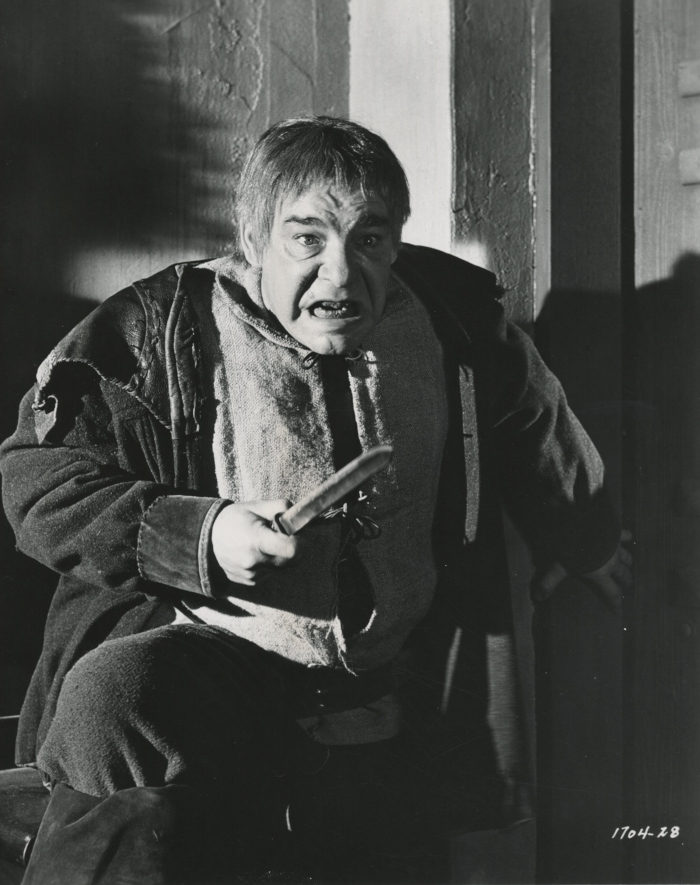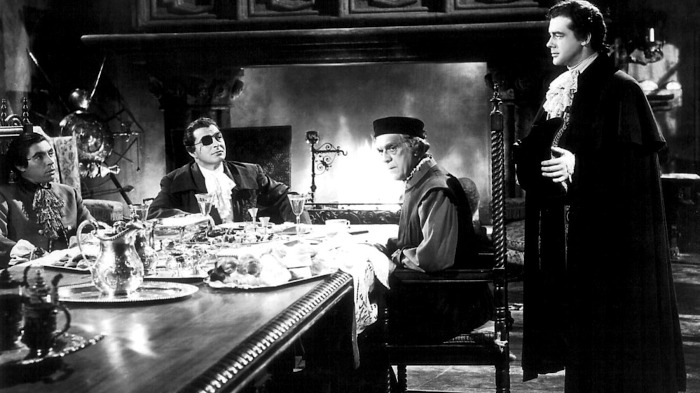Like The Strange Door, released the previous year, Universal’s The Black Castle is more of a Gothic melodrama than an actual horror film but, again like its predecessor, it has just enough genre trappings to make it a good enough fit here – there’s the threat of being buried alive (during a raging thunderstorm of course), mad noblemen and an old dark castle to tide us over some of the film’s slower moments.
In 19th Century Austria, British officer Sir Ronald Burton (Richard Greene), passing himself off as Richard Beckett, investigates the doings of Count Carl Von Bruno (Stephen McNally) while searching for two friends who disappeared after meeting the count. At first, the eye patched Von Bruno seems affable enough but Burton soon finds a well-stocked torture dungeon, a crocodile pit guarding the only exit from the castle and a black panther that Von Bruno plans to set free and hunt. The rest of his household consists of a doctor, Messien (Boris Karloff), a lumbering, mute handyman, Gargan (Lon Chaney Jr) who has his own reasons for despising the British, and Von Bruno’s beautiful wife Elga (Rita Corday, billed here as Paula Corday) who barely hides her hatred of her husband. When Von Bruno realises that Elga and Burton have become romantically involved, Burton’s cover is blown and the couple end up in the dungeon, destined for torture, The only thing that can say them is Messien’s drug that will give them the appearance of death, allowing him to smuggle their “bodies” out of the castle – but will Von Bruno see through the plan?

The Black Castle was the first film directed by Nathan Juran, a former art director who sometimes signed his name Nathan Herz. He got the gig just two weeks before filming was set to begin, when the originally assigned director, The Strange Door‘s Joseph Pevney, dropped out. Juran was never a particularly distinctive director (though he directed many much-loved fantasy films, including 20 Million Miles to Earth (1957), The 7th Voyage of Sinbad (1958) and Jack the Giant Killer (1962) and several more divisive ones, like The Brain from Planet Arous (1957) and Attack of the 50 Foot Woman (1958)) but he handles his duties well enough. Writer Jerry Sackheim, who had also written The Strange Door, brings plenty of derring-do, flashing blades and despicable aristos to the party so the film certainly has plenty of Saturday matinee charms that Juran runs with enthusiastically.
What it doesn’t have, sadly, is a scenery-chewing villainous performance to match Charles Laughton’s marvellously unhinged turn in The Strange Door. McNally is decent enough, but too restrained to do the part full justice (though Laughton’s detractors might welcome the more reined in performance). Again as in The Strange Door, Karloff gets little to do and the female lead, Corday, is largely there to be rescued and look pretty and on that score she does everything that’s asked of her. But poor Lon Chaney… Already starting to display the effects of his years of heavy drinking, he’s a mere shadow of his former self here, reduced to wordless grunting and mumbling in a thankless supporting role. He was still a way from the depths that his career would eventually plummet to (Al Adamson was still two decades away), but he was certainly on that slippery slope.

The film leans heavily on British import Richard Greene who had already made a string of historical action dramas (The Fighting O’Flynn (1949), The Desert Hawk (1950), Shadow of the Eagle (1950), La rivale dell’imperatrice/The Rival of the Empress (1951), Lorna Doone (1951) et al) so was well-versed in this swashbuckling business – a few years later he’d be on British televisions week in, week out taking the title role in the hugely popular The Adventures of Robin Hood (1955-1959) and he’s his typically suave and easy going self here.
The Black Castle has all the usual gloss one expects from a Universal film, Bernard Herzbrun and Alfred Sweeney providing some lovely sets that cinematographer Irving Glassberg lights atmospherically, so it’s handsomely mounted and mostly well-played but a little too dry and flavourless for its own good. It feels like it keeps threatening to become The Most Dangerous Game (1932), though it never does, and feels instead rather like Universal were eyeing up the family market. It really needed to be more full-blooded horror or at least to let loose a bit more enthusiastically with the Gothic bodice-ripper elements.

Like The Strange Door, The Black Castle is a missed opportunity, and it wasn’t a box office success, putting the brakes on any hopes that Universal might be about to resume horror production. Besides, science fiction was rapidly becoming the genre of choice for fans of the fantastique, and it would be a few more years before Hammer Films revived horror is spectacular fashion.